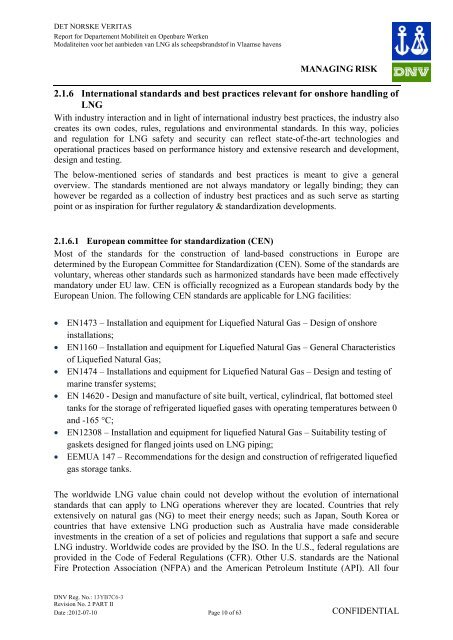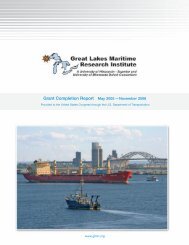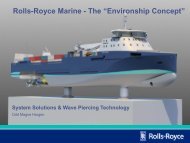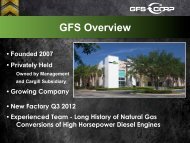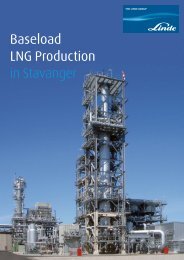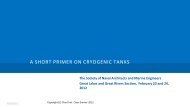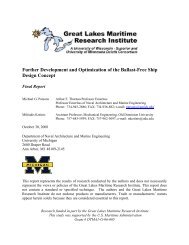Modalities for the provisioning of LNG as shipping fuel in Flemish Ports
Modalities for the provisioning of LNG as shipping fuel in Flemish Ports
Modalities for the provisioning of LNG as shipping fuel in Flemish Ports
Create successful ePaper yourself
Turn your PDF publications into a flip-book with our unique Google optimized e-Paper software.
DET NORSKE VERITAS<br />
Report <strong>for</strong> Departement Mobiliteit en Openbare Werken<br />
Modaliteiten voor het aanbieden van <strong>LNG</strong> als scheepsbrandst<strong>of</strong> <strong>in</strong> Vlaamse havens<br />
MANAGING RISK<br />
2.1.6 International standards and best practices relevant <strong>for</strong> onshore handl<strong>in</strong>g <strong>of</strong><br />
<strong>LNG</strong><br />
With <strong>in</strong>dustry <strong>in</strong>teraction and <strong>in</strong> light <strong>of</strong> <strong>in</strong>ternational <strong>in</strong>dustry best practices, <strong>the</strong> <strong>in</strong>dustry also<br />
creates its own codes, rules, regulations and environmental standards. In this way, policies<br />
and regulation <strong>for</strong> <strong>LNG</strong> safety and security can reflect state-<strong>of</strong>-<strong>the</strong>-art technologies and<br />
operational practices b<strong>as</strong>ed on per<strong>for</strong>mance history and extensive research and development,<br />
design and test<strong>in</strong>g.<br />
The below-mentioned series <strong>of</strong> standards and best practices is meant to give a general<br />
overview. The standards mentioned are not always mandatory or legally b<strong>in</strong>d<strong>in</strong>g; <strong>the</strong>y can<br />
however be regarded <strong>as</strong> a collection <strong>of</strong> <strong>in</strong>dustry best practices and <strong>as</strong> such serve <strong>as</strong> start<strong>in</strong>g<br />
po<strong>in</strong>t or <strong>as</strong> <strong>in</strong>spiration <strong>for</strong> fur<strong>the</strong>r regulatory & standardization developments.<br />
2.1.6.1 European committee <strong>for</strong> standardization (CEN)<br />
Most <strong>of</strong> <strong>the</strong> standards <strong>for</strong> <strong>the</strong> construction <strong>of</strong> land-b<strong>as</strong>ed constructions <strong>in</strong> Europe are<br />
determ<strong>in</strong>ed by <strong>the</strong> European Committee <strong>for</strong> Standardization (CEN). Some <strong>of</strong> <strong>the</strong> standards are<br />
voluntary, where<strong>as</strong> o<strong>the</strong>r standards such <strong>as</strong> harmonized standards have been made effectively<br />
mandatory under EU law. CEN is <strong>of</strong>ficially recognized <strong>as</strong> a European standards body by <strong>the</strong><br />
European Union. The follow<strong>in</strong>g CEN standards are applicable <strong>for</strong> <strong>LNG</strong> facilities:<br />
EN1473 – Installation and equipment <strong>for</strong> Liquefied Natural G<strong>as</strong> – Design <strong>of</strong> onshore<br />
<strong>in</strong>stallations;<br />
EN1160 – Installation and equipment <strong>for</strong> Liquefied Natural G<strong>as</strong> – General Characteristics<br />
<strong>of</strong> Liquefied Natural G<strong>as</strong>;<br />
EN1474 – Installations and equipment <strong>for</strong> Liquefied Natural G<strong>as</strong> – Design and test<strong>in</strong>g <strong>of</strong><br />
mar<strong>in</strong>e transfer systems;<br />
EN 14620 - Design and manufacture <strong>of</strong> site built, vertical, cyl<strong>in</strong>drical, flat bottomed steel<br />
tanks <strong>for</strong> <strong>the</strong> storage <strong>of</strong> refrigerated liquefied g<strong>as</strong>es with operat<strong>in</strong>g temperatures between 0<br />
and -165 °C;<br />
EN12308 – Installation and equipment <strong>for</strong> liquefied Natural G<strong>as</strong> – Suitability test<strong>in</strong>g <strong>of</strong><br />
g<strong>as</strong>kets designed <strong>for</strong> flanged jo<strong>in</strong>ts used on <strong>LNG</strong> pip<strong>in</strong>g;<br />
EEMUA 147 – Recommendations <strong>for</strong> <strong>the</strong> design and construction <strong>of</strong> refrigerated liquefied<br />
g<strong>as</strong> storage tanks.<br />
The worldwide <strong>LNG</strong> value cha<strong>in</strong> could not develop without <strong>the</strong> evolution <strong>of</strong> <strong>in</strong>ternational<br />
standards that can apply to <strong>LNG</strong> operations wherever <strong>the</strong>y are located. Countries that rely<br />
extensively on natural g<strong>as</strong> (NG) to meet <strong>the</strong>ir energy needs; such <strong>as</strong> Japan, South Korea or<br />
countries that have extensive <strong>LNG</strong> production such <strong>as</strong> Australia have made considerable<br />
<strong>in</strong>vestments <strong>in</strong> <strong>the</strong> creation <strong>of</strong> a set <strong>of</strong> policies and regulations that support a safe and secure<br />
<strong>LNG</strong> <strong>in</strong>dustry. Worldwide codes are provided by <strong>the</strong> ISO. In <strong>the</strong> U.S., federal regulations are<br />
provided <strong>in</strong> <strong>the</strong> Code <strong>of</strong> Federal Regulations (CFR). O<strong>the</strong>r U.S. standards are <strong>the</strong> National<br />
Fire Protection Association (NFPA) and <strong>the</strong> American Petroleum Institute (API). All four<br />
DNV Reg. No.: 13YB7C6-3<br />
Revision No. 2 PART II<br />
Date :2012-07-10 Page 10 <strong>of</strong> 63 CONFIDENTIAL


